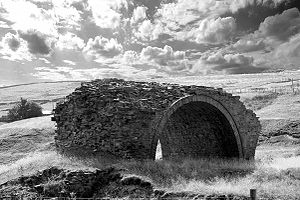
Rookhope
Encyclopedia

County Durham
County Durham is a ceremonial county and unitary district in north east England. The county town is Durham. The largest settlement in the ceremonial county is the town of Darlington...
, in England
England
England is a country that is part of the United Kingdom. It shares land borders with Scotland to the north and Wales to the west; the Irish Sea is to the north west, the Celtic Sea to the south west, with the North Sea to the east and the English Channel to the south separating it from continental...
. A former lead and fluorspar mining community, it first existed as a group of cattle farms in the 13th Century. It is situated in the Pennines
Pennines
The Pennines are a low-rising mountain range, separating the North West of England from Yorkshire and the North East.Often described as the "backbone of England", they form a more-or-less continuous range stretching from the Peak District in Derbyshire, around the northern and eastern edges of...
to the north of Weardale
Weardale
Weardale is a dale, or valley, of the east side of the Pennines in County Durham, in England. Large parts of Weardale fall within the North Pennines Area of Outstanding Natural Beauty - the second largest AONB in England and Wales. The upper valley is surrounded by high fells and heather grouse...
. W. H. Auden once called Rookhope 'the most wonderfully desolate of all the dales'.
The village pub, the Rookhope Inn and the Swallow's Rest on the fell surrounding Rookhope are popular with cyclists on the coast to coast cycling route which runs from Sunderland on the east coast to Whitehaven on the west coast of northern England.
Rookhope Arch
A local landmark is the Rookhope Arch at Lintzgarth, a few hundred yards west up the valley; one of the few remaining parts of the two mile (3 km) Rookhope Chimney. This "horizontal" chimney (parallel to the ground, which actually rises steeply to the moors) was used to carry poisonous flue gases from the Rookhope lead smelting works up onto the high moor. Periodically, lead and silver carried over in the gases and deposited in the chimney were dug out and recovered, rather than going to waste.The Rookhope Ride
The Rookhope Ride is a ballad rescued and noted down by Joseph RitsonJoseph Ritson
Joseph Ritson was an English antiquary.He was born at Stockton-on-Tees, of a Westmorland yeoman family. He was educated for the law, and settled in London as a conveyancer at the age of twenty-two. He devoted his spare time to literature, and in 1782 published an attack on Thomas Warton's History...
from the chanting of George Collingwood of Boltsburn near Rookhope about 1785. The date of the action (a raid) is precise: 6 December [1569?], when robbers from Tynedale
Tynedale
Tynedale was a local government district in south-west Northumberland, England. It had a resident population of 58,808 according to the 2001 Census, and was named after the River Tyne . Its main towns were Hexham, Haltwhistle and Prudhoe...
made a foray into Weardale
Weardale
Weardale is a dale, or valley, of the east side of the Pennines in County Durham, in England. Large parts of Weardale fall within the North Pennines Area of Outstanding Natural Beauty - the second largest AONB in England and Wales. The upper valley is surrounded by high fells and heather grouse...
.
W.H.Auden
The poet W. H. AudenW. H. Auden
Wystan Hugh Auden , who published as W. H. Auden, was an Anglo-American poet,The first definition of "Anglo-American" in the OED is: "Of, belonging to, or involving both England and America." See also the definition "English in origin or birth, American by settlement or citizenship" in See also...
was familiar with this whole area of the North Pennines and its derelict lead mines, and stated in 'New Year Letter' that it was in Rookhope that he first became aware of himself as a poet:
In ROOKHOPE I was first aware
Of self and not-self, Death and Dread...
In this poem he refers to dropping a pebble down a mine-shaft on top of neighbouring Bolt's Law.

